“William” Tell Comes to New York
I assume you all know the name of Wilhelm Tell (written the Swiss way), but do you know the story behind it?
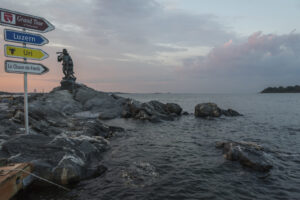
I recently had the most rewarding photography job of my life. It included a world famous artist, a tiny island only 7 miles from where Cindy and I live, and combining 725 years of Swiss history and the United States together in one historic moment. (Video-link at the end of the blog)
There’s this island in Long Island Sound called Rat Island. Actually, it is in New York City, in the Bronx. The island was bought a few years ago by two Swiss nationals, Alex Schibli and Roland Veit. Gerry Hofstetter a world famous Swiss known for his Light Art had the “crazy” idea to bring Wilhelm Tell (or better known as William Tell for the Americans) to New York. If you ask any American to explain the story of William Tell, they’ll tell you it has something to do with an apple, but not more . And that’s understandable. It’s a great, but very local story.
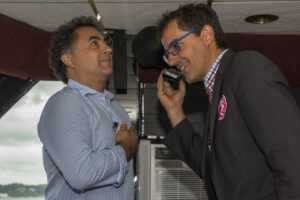
The story of Wilhelm Tell (from Wikipedia)
At a time soon after the opening of the Gotthard Pass, when the Habsburg emperors of Vienna sought to control Uri and thus control trans-Alpine trade, a new bailiff, Hermann Gessler, was despatched to Altdorf. The proud mountain folk of Uri had already joined with their Schwyzer and Nidwaldner neighbours at Rütli in pledging to resist the Austrians’ cruel oppression, and when Gessler raised a pole in the central square of Altdorf and perched his hat on the top, commanding all who passed before it to bow in respect, it was the last straw.
William Tell, a countryman from nearby Bürglen, either hadn’t heard about Gessler’s command or chose to ignore it; whichever, he walked past the hat without bowing. Gessler seized Tell, who was well known as a marksman, and set him a challenge. He ordered him to shoot an apple off his son’s head with his crossbow; if Tell was successful, he would be released, but if he failed or refused, both he and his son would die.
The boy’s hands were tied. Tell put one arrow in his quiver and another in his crossbow, took aim, and shot the apple clean off his son’s head. Gessler was impressed and infuriated – and then asked what the second arrow was for. Tell looked the tyrant in the eye and replied that if the first arrow had struck the child, the second would have been for Gessler. For such impertinence, Tell was arrested and sentenced to lifelong imprisonment in the dungeons of Gessler’s castle at Küssnacht, northeast of Luzern. During the long boat journey a violent storm arose on the lake, and the oarsmen – unfamiliar with the lake – begged with Gessler to release Tell so that he could steer them to safety. Gessler acceded, and Tell cannily manoeuvred the boat close to the shore, then leapt to freedom, landing on a flat rock (the Tellsplatte) and simultaneously pushing the boat back into the stormy waters.
Determined to see his task through and use the second arrow, Tell hurried to Küssnacht. As Gessler and his party walked along on a dark lane called Hohlegasse on their way to the castle, Tell leapt out, shot a bolt into the tyrant’s heart and melted back into the woods to return to Uri. His comrades were inspired by Tell’s act of bravery to throw off the yoke of Habsburg oppression in their homeland, and to remain forever free.
Tell means a lot to the Swiss. Still today the symbol of the crossbow stands for Swiss quality.
Gerry wanted to bring this story to America. In his own words, he has said:
If you have a dream or an idea,
be careful, it may be a vision.
If your heart catches the spirit of that vision,
Realize it, with passion.
And never forget, success is the only solution.
The project to bring Tell to NYC started in February of this year. Erecting a statue in NYC requires a permit. And in order to get a permit, you need an address. Of course, this tiny island has no roads or houses. So in order to get this permit, Alex came up with an address – 1291 Wilhelm Tell Square. 1291, you may know, was the year Switzerland was founded. So all is right in the world, Tell now lives at a proper address. You can even send him mail!
All this went through the NYC bureaucracy faster than you can imagine. Side note: If Donald Trump would know how fast this went, he would say “something is wrong here, very wrong, very wrong. It takes longer, longer when I build – believe me, so something is wrong”.
Wilhelm Tell arrived in New York 10 days before the Swiss National Day which is August 1st – called 1st of August in Switzerland, the equivalent of the American Fourth of July. It was transported by a wooden raft (like on the lake of Uri when he jumped onto the flat rock and pushed the boat back into the rough water) to the island a few days later. More on that in my second blog. I will write about how everything came together once Tell arrived in New York.
Besides the Tell statue, also erected are street direction signs. Like Luzern (the town I grew up and lived until 7 and then again from 15 – 26. And Uri where I turned into a real boy from 7 – 14. I lived in Erstfeld and the Original Wilhelm Tell monument was only 4 miles away. These two signs are amazingly coincidental to my life’s story.
Now from my home on Long Island, Tell is only a 7 miles away. The heart and spirit of Switzerland is now so close. The original monument was put in place in Altdorf, Canton of Uri in 1895.
Gerry Hofstetter says he placed Tell into New York to “support Lady Liberty, so they can together strengthen human rights as fundamental values of mankind”.
This is a video Henry Maurer did and broadcasted by Swiss TV (Spoken in Swiss German).
Swiss Newspaper Neue Zürcher Zeitung.
More about Gerry Hofstetter – great video. One of his projects filmed by Henry Maurer was the illumination of Swiss Alpine Huts (scroll down to Highlights/Gerry Hofstetter – SAC Trailer) for their 150th Anniversary.
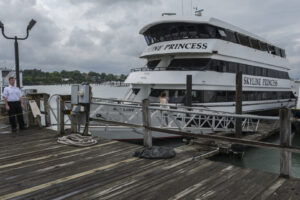 Waiting for the guests to arrive.[/caption]
[caption id="attachment_2526" align="aligncenter" width="300"]
Waiting for the guests to arrive.[/caption]
[caption id="attachment_2526" align="aligncenter" width="300"] The captain with Gerry and his 2 daughters.[/caption]
[caption id="attachment_2523" align="aligncenter" width="300"]
The captain with Gerry and his 2 daughters.[/caption]
[caption id="attachment_2523" align="aligncenter" width="300"]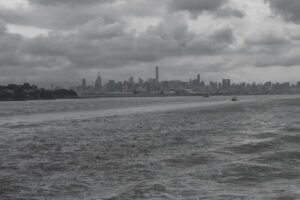 Skyline of Manhattan[/caption]
[caption id="attachment_2521" align="aligncenter" width="300"]
Skyline of Manhattan[/caption]
[caption id="attachment_2521" align="aligncenter" width="300"] Eliane Amherd from the Übersee Band[/caption]
[caption id="attachment_2520" align="aligncenter" width="300"]
Eliane Amherd from the Übersee Band[/caption]
[caption id="attachment_2520" align="aligncenter" width="300"] Erich Nageli, Swiss Chef with his crew[/caption]
Erich Nageli, Swiss Chef with his crew[/caption]
[caption id="attachment_2522" align="aligncenter" width="300"]
 Typical Swiss Food :)[/caption]
[caption id="attachment_2525" align="aligncenter" width="300"]
Typical Swiss Food :)[/caption]
[caption id="attachment_2525" align="aligncenter" width="300"]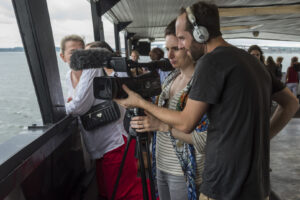 Swiss Television Team[/caption]
[caption id="attachment_2529" align="aligncenter" width="300"]
Swiss Television Team[/caption]
[caption id="attachment_2529" align="aligncenter" width="300"]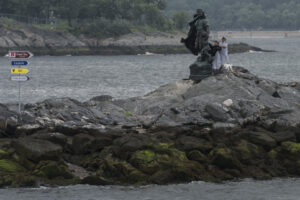 “Unwrapping” Wilhelm Tell by Marines[/caption]
“Unwrapping” Wilhelm Tell by Marines[/caption]
[caption id="attachment_2531" align="aligncenter" width="300"]
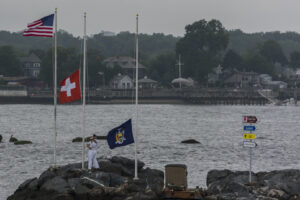 While playing the Swiss National Hymne, the Marines raise the Swiss Flag[/caption]
[caption id="attachment_2524" align="aligncenter" width="300"]
While playing the Swiss National Hymne, the Marines raise the Swiss Flag[/caption]
[caption id="attachment_2524" align="aligncenter" width="300"] Live broadcast to Switzerland. Gerry and Giovanni[/caption]
[caption id="attachment_2530" align="aligncenter" width="300"]
Live broadcast to Switzerland. Gerry and Giovanni[/caption]
[caption id="attachment_2530" align="aligncenter" width="300"] Emotionell and everybody is happy.[/caption]
[caption id="attachment_2532" align="aligncenter" width="300"]
Emotionell and everybody is happy.[/caption]
[caption id="attachment_2532" align="aligncenter" width="300"]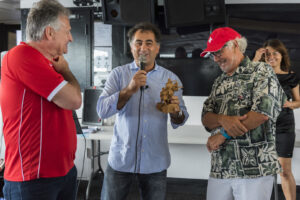 Gerry thanks the 2 owners of the island Roland Veit and Alex Schibli.[/caption]
[caption id="attachment_2533" align="aligncenter" width="300"]
Gerry thanks the 2 owners of the island Roland Veit and Alex Schibli.[/caption]
[caption id="attachment_2533" align="aligncenter" width="300"]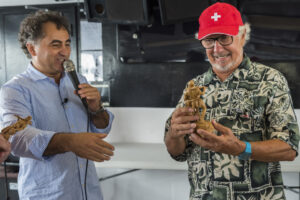 Alex receives a wooden carved Tell and loves it.[/caption]
[caption id="attachment_2534" align="aligncenter" width="300"]
Alex receives a wooden carved Tell and loves it.[/caption]
[caption id="attachment_2534" align="aligncenter" width="300"]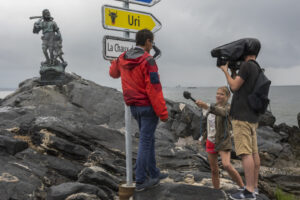 Giovanni in an interview for the French speaking TV channel.[/caption]
[caption id="attachment_2535" align="aligncenter" width="300"]
Giovanni in an interview for the French speaking TV channel.[/caption]
[caption id="attachment_2535" align="aligncenter" width="300"]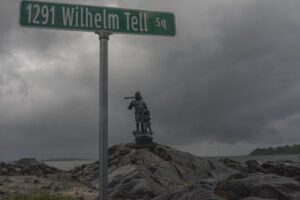 Wilhelm Tell on his own square.[/caption]
[caption id="attachment_2519" align="aligncenter" width="300"]
Wilhelm Tell on his own square.[/caption]
[caption id="attachment_2519" align="aligncenter" width="300"] Facing the Statue of Liberty – Together they are even stronger.
Facing the Statue of Liberty – Together they are even stronger.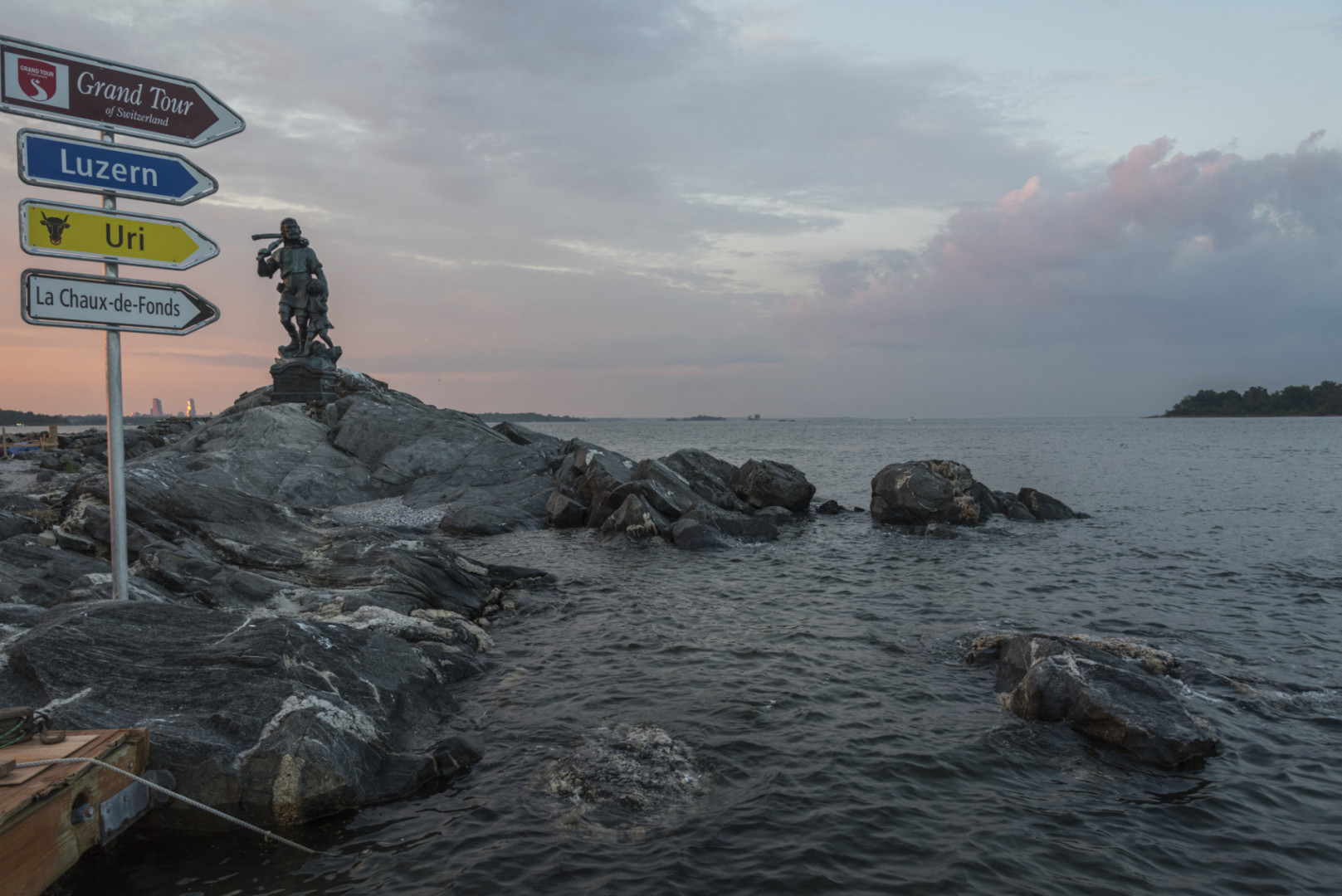
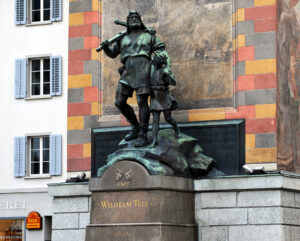
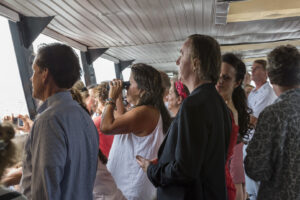
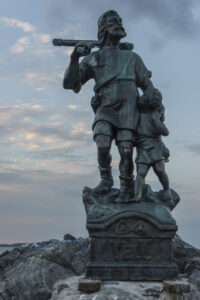
12 Comments